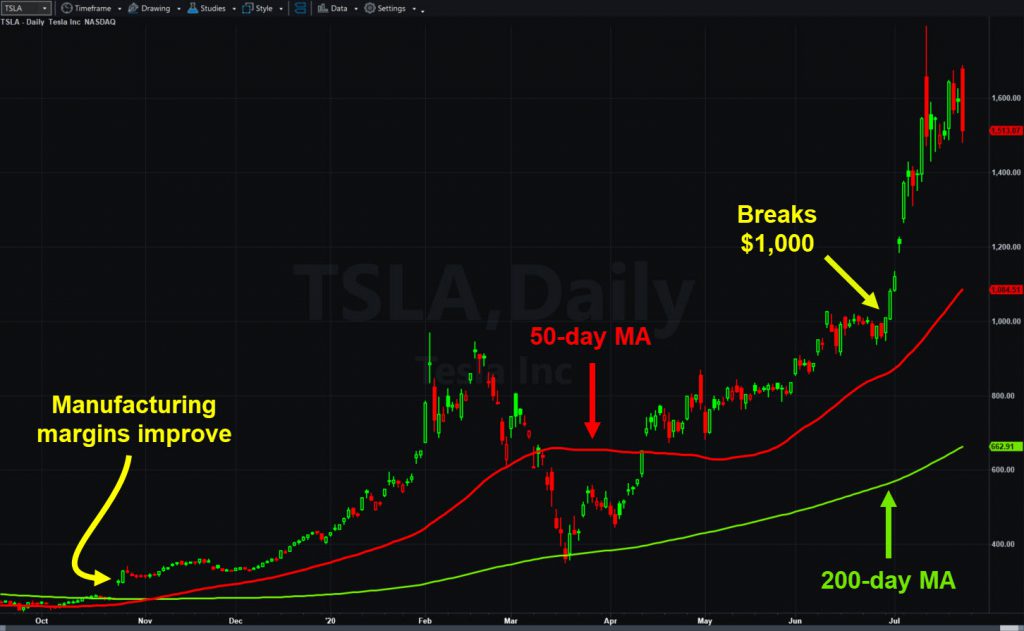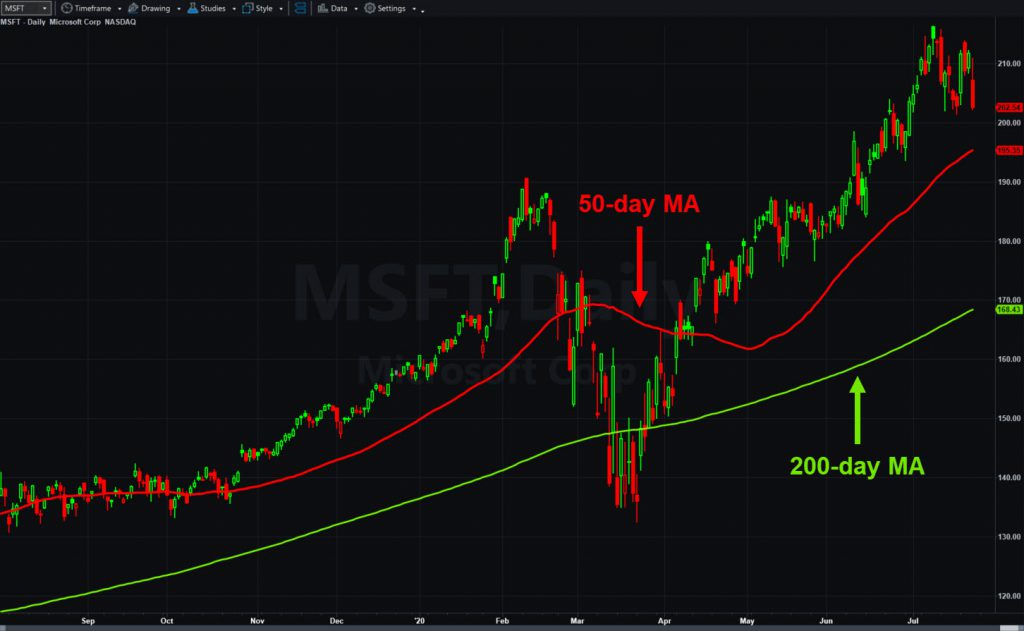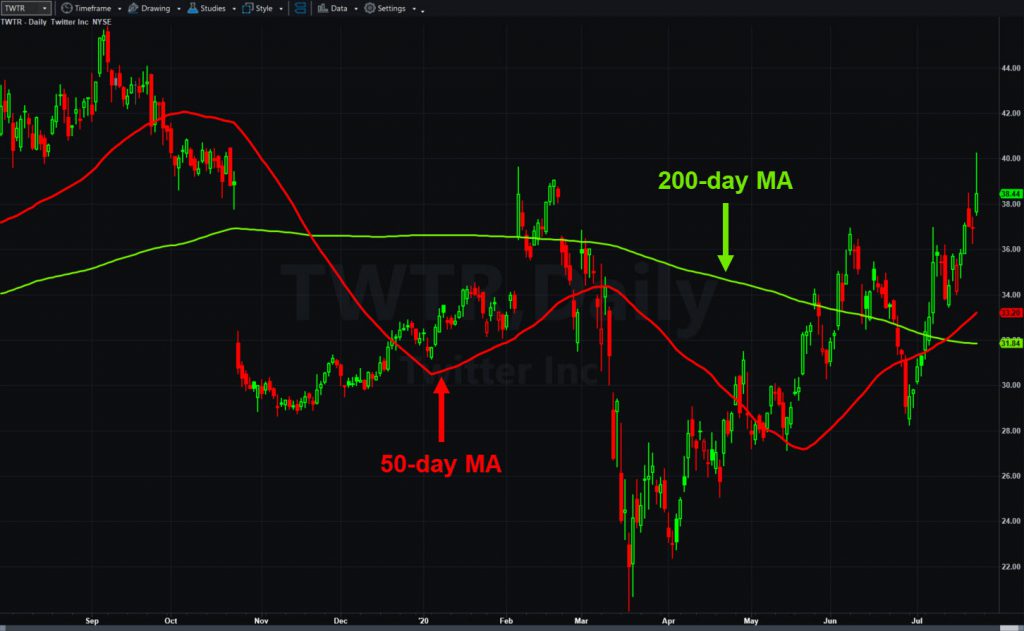This week’s earnings featured a huge quarter from electric-car maker Tesla and several positive surprises in the housing space.
TSLA’s earnings and revenue beat estimates in the second quarter, despite coronavirus shuttering some factories. Its manufacturing practices continued to evolve, lifting profitability and further proving the company can scale into a global powerhouse.
The results also seemed to justify TSLA’s 300 percent rally from its March lows, and 50 percent gain in July. It’s now almost certain to be included in the S&P 500, although the timing is unclear.

Now that it’s established profitability, TSLA may become more like Apple (AAPL) — wowing investors with innovations and volume growth. These are some of the things CEO Elon Musk is focusing on next:
- Delivering at least 500,000 vehicles this year. That would be up from 367,000 in 2019 and 245,240 in 2018.
- Lowering prices to widen its user base. This strategy has worked wonders for AAPL lately.
- Growing in China. TSLA cut the initial deposit for would-be buyers and is quickly bringing its Shanghai gigafactory online.
- Expanding in the U.S. The company also announced plans to build another plant in Austin, Texas. Some enthusiasts are starting to wonder if TSLA will reach 1 million deliveries by 2022.
- “Battery Day” is set for September 22. The big product demo will be around the same time AAPL normally releases new iPhones. Coincidence?
Housing Remains Strong
Housing-related stocks were another bright spot this week as demand increases and inventories remain tight. Homebuilder PulteGroup (PHM) shot to a four-month high after profit and revenue beat estimates.
Appliance maker Whirlpool (WHR) is also up more than 10 percent this week after cruising past analysts’ forecasts and raising guidance.
Attention may now shift to the broader housing industry with key ETFs like iShares US Home Construction (ITB) and SPDR S&P Homebuilders (XHB) back near record highs. Will traders look for breakouts with new-home sales later this morning? The Federal Reserve is also expected to keep pushing super-low interest rates next Wednesday.

Microsoft: Sell the News?
Microsoft (MSFT) rallied into its report as coronavirus fueled demand for software and cloud computing. The technology giant beat estimates for earnings and revenue. However the shares fell because optimism had lifted them near record highs.
As the old saying goes, buy the rumor and sell the news. MSFT rallied into the report and then sellers took profits once the good news became public.
The weak economy, with millions of Americans out of work and countless businesses disrupted, was another headwind. Management sees revenue from Productivity & Business Processes and Intelligent Cloud both missing the $12 billion mark this quarter. The Azure enterprise cloud-computing division also lagged some estimates last quarter.
Intel & the Chips
Intel’s (INTC) sales and profit beat estimates thanks to cloud computing strength and PC demand. However problems rolling out 7-nanometer products squeezed profit margins and caused sellers to hammer the chip giant after hours last night.
There are two takeaways from the INTC news:
- Advanced Micro Devices (AMD), which is already selling 7-nanometer chips, rose on the prospect of delayed competition from INTC.
- INTC may rally if management overcomes the production issues, resulting in wider profit margins. Just look at TSLA in late 2019.
Other semiconductors inched lower despite beating estimates, like Texas Instruments (TXN) and Teradyne (TER).
Twitter’s Traffic Surge
Twitter (TWTR) had an interesting quarter. Earnings and revenue missed. But its monetizable daily active users (mDAUs) came in at 186 million — about 13 million more than expected.
That’s a potential sign that Jack Dorsey’s social-media firm has gained market share. Even if advertising is weak now because of the recession, it could give investors more confidence in TWTR’s long-term prospects.

Snap (SNAP) was just the opposite. Its earnings and revenue beat, while usage missed. The smaller social-media company had more than doubled from its March amid the success of its direct-response (DR) advertising.
Health Care Rallies
This week also saw rallies in health-care companies that are often ignored.
Hospital operator HCA (HCA) surged 20 percent in the first four sessions of the week after crushing estimates. Admissions fell less than feared after the initial Covid-19 disruption. Analysts now see potential benefits as patients undergo delayed procedures and hospitals collect money from the CARES Act.
Intuitive Surgical (ISRG), a provider of robotic surgical devices, enjoyed a similar pop.
Investors may want to keep an eye on health care because it’s relatively recession proof. Doctors’ offices also took a major hit from the pandemic, but how long will the industry remain shut down?
In conclusion, TSLA had the most important earnings report this week — potentially cementing its place in the market for decades into the future. A poor economy hurt MSFT and manufacturing problems weighed on INTC. Housing remained strong, while TWTR and hospital-related stocks seemed to gain traction.





















